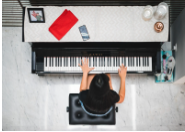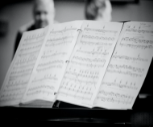The standards for High School Choral Music, Intermediate Level enable students to build upon the skills and knowledge acquired at the beginning level. Students continue the development of vocal production techniques and ensemble participation, and perform music from a variety of music styles, composers, cultural influences, and historical periods. Students continue to develop and refine personal choral music ideas. Students explore choral music as a means of expression and communication. Through the collaborative environment of the choral setting, students develop an understanding of teamwork and leadership skills and develop an understanding of appropriate etiquette as a performer and as an audience member. Students compare and contrast career options in music and make cross-curricular connections to explore how music works together with other disciplines to develop innovative solutions to problems. Opportunities are provided for students to participate in local, district, and regional music events as appropriate to level, ability, and interest. After-school rehearsals and performances may be required of students. Content in this course changes annually; therefore, this course may be repeated.
Audition and/or Director's approval
Essential Question: How do I evolve the musical instrument I was born with to express myself as a citizen of the global community?
|
Quarter |
Quarter 1 |
Quarter 2 |
Quarter 3 |
Quarter 4 |
|
Unit Title |
Zooming Out: Reading Around the Notes. |
Responding Through Analyzation, Evaluation, Critique, and Reflection |
Creation, Skill Development and Reflection Evolve with Practice |
Discovering the Global Community Through Experience and Creation |
|
Image Cue |
|

|

|

|
|
Focus of the Story |
Our year begins with a review of vocal wellness and health as we expand our musical literacy. Reading beyond our part in isolation develops our self-awareness for our voices as they grow for solo and ensemble singing. |
We continue to grow by examining the music we’ve created and experienced in the classroom and on stage in performances. We apply our learning through listening and self-awareness while developing musical expressiveness both alone and within an ensemble. |
Next, we focus on our ability to provide and receive critiques on our work as individuals and an ensemble. Assessing and using feedback to grow is the primary means to gain independence as composers and performers. |
The year culminates through research and performance, where we discover other cultures, languages and musical experiences. Refining literacy and vocal technique allows us to elevate our composition skills as we prepare and perform final solo and group ensemble projects . |
|
Transfer Goals |
Understand and apply creative processes to guide the development of ideas, original works, and musical performance. Analyze, interpret, and evaluate musical works from a variety of cultures. Use music literacy to demonstrate understanding of the elements of music and the ways they inform artistic performance and creative expression. |
Understand and apply creative processes to guide the development of ideas, original works, and musical performance. Analyze, interpret, and evaluate musical works from a variety of cultures. Use music literacy to demonstrate understanding of the elements of music and the ways they inform artistic performance and creative expression. Use technology as a strategic mechanism for improving music literacy and improving music performance. |
Understand and apply creative processes to guide the development of ideas, original works, and musical performance. Analyze, interpret, and evaluate musical works from a variety of cultures. Understand and find meaning in music as a form of community engagement through involvement as a performer, supporter, advocate, and audience member. Curate a portfolio of accomplishments, experiences, and performance materials exhibiting oneself as an artist. Use music literacy to demonstrate understanding of the elements of music and the ways they inform artistic performance and creative expression. |
Understand and apply creative processes to guide the development of ideas, original works, and musical performance. Analyze, interpret, and evaluate musical works from a variety of cultures. Explore and connect personal interests, experiences, and aspirations through vocation, advocacy, and arts patronage. Curate a portfolio of accomplishments, experiences, and performance materials exhibiting oneself as an artist. Use music literacy to demonstrate understanding of the elements of music and the ways they inform artistic performance and creative expression. Use technology as a strategic mechanism for improving music literacy and improving music performance. |
|
Learning Targets |
I can demonstrate proper rehearsal etiquette. I can cooperate and collaborate as a singer in a rehearsal. I can identify the components of a musical score. I can follow my part throughout a musical score. I can identify the difference between a cappella and accompanied singing. I can demonstrate both head and chest voice. I can correctly participate in vocal warm ups to develop vocal agility and range. I can identify my vocal range using a piano keyboard. I can interpret music using music terminology. I can read and count rhythmic patterns in simple and compound meters. I can conduct in a duple meter using expressive gestures, articulation, and various tempi. I can describe how the parts of the vocal anatomy work together. I can describe vocal health issues and how to prevent them. I can sing my assigned part within the ensemble. I can prepare for an audition. |
I can create and perform simple rhythmic and melodic examples in call-and-response styles. I can evaluate a piece of music or performance using musical terminology. I can demonstrate collaborative skill in a performance. I can aurally identify ascending and descending whole and half steps. I can sit and stand using proper choral posture and breathing techniques. I can listen while I sing and adjust my intonation, diction, dynamics, rhythm, and tone to contribute to a good choral blend. I can respond to a wide variety of conducting patterns and interpretive gestures. I can sing expressively using proper facial and physical expression. I can compose a eight-measure rhythmic-melodic variation. I can critique a music performance using musical terminology. I can analyze ways in which music can evoke emotion and be persuasive. I can apply the rules for identifying key signatures. I can identify musical structure by ear. I can write simple four-measure melodic phrases from dictation. I can write eight-measure rhythmic phrases from dictation. I can interpret the components of a vocal score. I can play a four-measure melodic phrase on the keyboard. |
I can begin and develop an original composition. I can receive and give constructive criticism about compositions. I can describe personal emotional and intellectual responses to works of music using music terminology. I can apply ethical standards while creating original music. I can explore ways in which technology can be used to create or share new works of music. I can identify the intervals m2, m3, M6, m7 by ear and play on the piano. I can write simple four-measure melodic phrases from dictation. I can write a musical variation. I can sight-sing eight-measures in two parts with solfege. I can sing major and minor scales using solfege. I can correctly and notate my composition. |
I can identify and describe the social, cultural, and historical context of the repertoire we are studying. I can use credible resources to obtain information about culture and history. I can describe and demonstrate collaborative skill in a performance. I can perform music in a language other than English. I can perform music with and without accompaniment. I can respond to music with appropriate movement by applying various styles of choreography. I can discuss the value of music to my community. I can identify career options in music. I can use credible resources to obtain information about careers I can use credible resources to obtain information about the relationship of vocal music to other fields of knowledge. I can play on the keyboard an eight-measure melody using scale degrees 1 through 5 of a major scale. |

